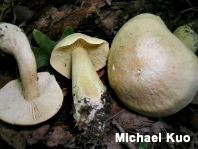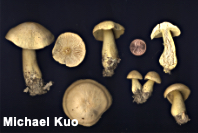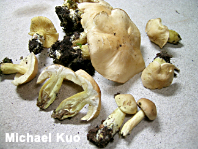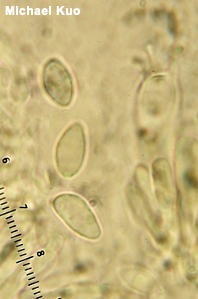| Major Groups > Gilled Mushrooms > Pale-Spored > Tricholoma > Tricholoma odorum |

|
Tricholoma odorum [ Basidiomycota > Agaricales > Tricholomataceae > Tricholoma . . . ] by Michael Kuo Eastern North America's Tricholoma odorum is aptly named; it reeks to high heaven. The distinctive odor, which becomes more prominent as the mushrooms mature (and even stronger when they're dried), is often described as reminiscent of coal tar or swamp gas. Several species of Tricholoma share this odor; among them, Tricholoma odorum is unique in having a preference for hardwood forests, coupled with pale yellowish to greenish colors that fade quickly to pale tan or buff. By maturity the yellows and greens have often disappeared almost completely, except on the stem. Tricholoma sulphureum is similarly stinky and similar in appearance, but its colors (cap, gills, stem, and flesh) are bright yellow and do not fade readily. Tricholoma bryogenum, newly described from Scandinavia and associated with spruces, is quite similar in appearance and odor; its presence in North American is not known. Description: Ecology: Mycorrhizal with hardwoods in oak-hickory or beech-maple forests; usually growing gregariously, sometimes in loose clusters; late summer and fall; fairly widely distributed in the Midwest and northeastern North America. The illustrated and described collections are from Illinois and Michigan. Cap: 3–6 cm; broadly convex with a shallow central bump; dry; bald; pale pale greenish yellow when young, but soon becoming pale tan or creamy brownish. Gills: Attached to the stem by means of a notch; close; short-gills frequent; pale yellowish; not bruising or discoloring. Stem: 3–6 cm long; up to 2 cm thick; more or less equal, or swollen toward the base; light greenish yellow when young, becoming brownish yellow; hollowing with age. Flesh: Whitish, but yellowish in the stem; not changing on exposure. Odor and Taste: Taste mealy; odor strong and foul, reminiscent of coal tar or swamp gas. Spore Print: White. Chemical Reactions: KOH negative on cap surface. Microscopic Features: Spores 7–11 x 4–5.5 µm; smooth; subamygdaliform; inamyloid; hyaline in KOH. Basidia 4-sterigmate; basally clamped. Cheilocystidia, pleurocystidia not found. REFERENCES: Peck, 1898. (Saccardo, 1902; Kauffman, 1918; Ovrebo, 1980; Phillips, 1991/2005; Binion et al., 2008; Kuo & Methven, 2010; Bessette et al., 2013; Christensen & Heilmann-Clausen, 2013; Kuo & Methven, 2014; Baroni, 2017; Sturgeon, 2018.) Herb. Kuo 09300501, 09150708. This site contains no information about the edibility or toxicity of mushrooms. |
© MushroomExpert.Com |
|
Cite this page as: Kuo, M. (2018, December). Tricholoma odorum. Retrieved from the MushroomExpert.Com Web site: http://www.mushroomexpert.com/tricholoma_odorum.html |



